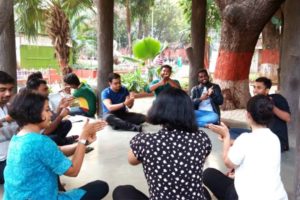International Day of Sign Languages: Recognising deaf culture
“It is such a shame that we only have close to 800 ISL interpreters in the entire country, among which only 300 are certified. Even the census is about a decade old. I am sure the number of people with hearing disability must have increased now,’’ Nipun Malhotra, a disability rights activist in Delhi, tells Media India Group.
In September 2018, Malhotra, who lives with a locomotor disability himself, filed a petition in the Delhi High Court to make Indian Sign Language India’s 23rd official language so that it can be preserved and promoted by the government. Though his petition was rejected by the high court, he says it started a much needed conversation around the ‘Deaf culture’ in India.
Deaf culture stands against the idea to force people to hear, insisting that oral language is not the only language that deserves legitimacy. “A fully formed linguistic culture exists around sign language and the idea that the hearing impaired people need to be ‘fixed’ by making them hear is flawed at its core. Deaf culture dismantles this idea, by emphasising the formation of strong communities, shared hobbies, and collective experiences,” Malhotra explains.
Malhotra is a sign language instructor at Noida Deaf Society, a classroom for learning ISL, in a three-storeyed building in Noida, on the outskirts of the national capital Delhi. He is one of the six ISL teachers who teach a group of 30 hearing impaired children and teenagers weekly.
To Malhotra and many others’ joy, the demand to add ISL to the list of officially recognised languages in India has resurfaced in last few months.
Bollywood actor Ranveer Singh recently released a sign language music video by rapper and poet, Spitfire called Vartalap (conversation) with deaf signer Hardeep Singh in ISL. The video, produced by Singh’s label IncInk, is part of a campaign to make ISL the 23rd official language of India. In this context, the actor also signed a petition by the National Association of the Deaf India.
The Covid-19 lockdown has been extremely difficult for India’s hearing impaired. Most orders, notices and clarifications were not accessible to them. “Children with hearing disabilities who were sent home from school were unable to study because many parents didn’t know ISL. Many could not call helplines or healthcare centres and that is why, it’s time we refocus on educating Indians on ISL and making it an official language,” adds Malhotra.
One of Malhotra’s students, 20-year-old Jyoti Makhija explains that her private school had no ISL-trained teachers or interpreters. As a result, she and her friends invented a personalised sign language to communicate, which Goyal explains, is a common practice among persons with hearing disability and others to whom language is denied. She says that she doesn’t view sign language as forced because of her hearing disability but as a unique culture, of which she is a part.
“I teach my parents and sibling what I learn here and now we’re able to make small conversations. I was embarrassed to express myself in sign language at public places or even in front of my friends until I came here and realised that it is not forced upon us, but a chosen culture to be cherished,” Makhija explains in sign language.
“The deaf are a tightly-knit community. They view deafness not as a medical condition to be cured, but as a cultural identity to be celebrated. If you look at any foreign language in India, it would have thousands of interpreters as against ISL, that’s an Indian language,” says Dhriti Goyal, who is a trained interpreter of sign language.

There are too few trained teachers of ISL to take care of the need in the country (Courtesy: Noida Deaf Society)
A thriving example of deaf culture exists in New Delhi’s Kamla Market. The Delhi Association for the Deaf was started in 1950, though it took on its present name only in 1977. Until then it was called the Deaf and Dumb Association – derogatory terms that have since been replaced with growing public awareness about the usage of ISL.
Members of the association participate in annual events like sports day (for school children), annual day, dating and marriage congregations, picnics and festival celebrations and avail assistance in navigating interactions with governments, local bodies and legal as well as other institutions. Every Wednesday and Saturday, members also come to the association’s premises to socialise. “These societies and gatherings keep the people of the community active and puts pressure on the ISLRTC for demanding their rights and making institutions across the country more comfortable and friendlier for deaf people,” Goyal says.
Though there is a very long and difficult way ahead for the deaf community in India to get recognised and be free of stigma and participate in the daily affairs of the society and country as an equal member, Goyal and Malhotra count on the recent achievements as a step towards a better tomorrow.
“In 2019 Cricket World Cup, for the first time there were sign language commentators and in March, ISLRTC came up with the second edition of its sign-language dictionary, as a follow-up to India’s first-ever ISL dictionary that was launched in 2018,” Goyal mentions.
For now, government programs focusing on skill development for people with disabilities and the improvement of physical and workforce accessibility are seen as steps in the right direction. However, Malhotra emphasises the need for awareness campaigns to make India’s deaf community known to the hearing majority.
“People at the policy level should be exposed to places where the deaf are working and learning,” signs Malhotra. “National organisations for the deaf are limited to Delhi and Mumbai, but they need to be scaled up and replicated across the country.”










